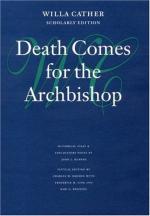|
This section contains 5,608 words (approx. 19 pages at 300 words per page) |

|
SOURCE: “Death Comes for the Archbishop,” in New Mexico Quarterly, Vol. XXVII, Nos. 1 and 2, Spring-Summer, 1957, pp. 69-82.
In the following essay, Greene characterizes Death Comes for the Archbishop as a “search for the moral self,” which he also believes informs Cather's other works.
Of the works of Willa Cather perhaps the most familiar to the general public, Death Comes for the Archbishop has, nevertheless, aroused conflicting response as to its merit. E. K. Brown, for example, has interpreted the text in terms of a “frieze.” “The composition of this frieze,” he writes, “in the grouping of its figures and their portrayal against a living background, is the most beautiful achievement of Willa Cather's imagination.” David Daiches, on the other hand, while admitting the popularity of the book, has found himself less impressed, “perhaps because its qualities, though considerable, are rather obvious.” Mr. Daiches pursues his suspicion of a...
|
This section contains 5,608 words (approx. 19 pages at 300 words per page) |

|


